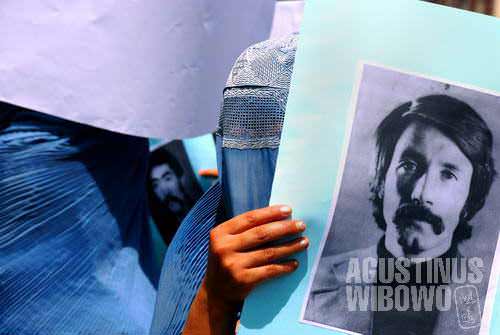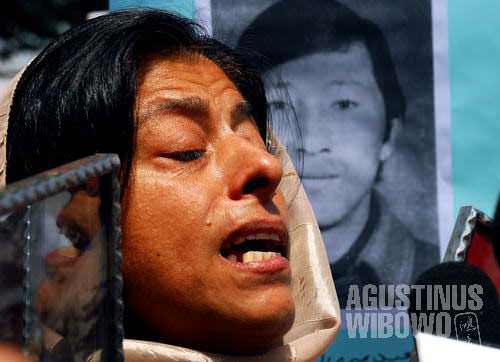Kabul – Women Call for Justice

Blue Demonstration
Under the scorching sun they yelled, they cried, they screamed. Many of them were completely wrapped by blue burqas. Many of them were invisible. But grieves and cries were heard and tears were felt. The message was clear: call for justice.
A group of more than 100 protesters, mostly women, held a demonstration in front of a UN mission office in Kabul today. They brought photos of men. The photos, seen from the fading black and white, are presumed old portraits. Who are the women? Who are the men?
Before we go further, let me introduced you to a happening in Kabul some weeks ago. A discovery of mass graves located in Dasht-e-Chamtala, a desert some kilometers away from Central Kabul, in early and mid-July, shocked the country. The last mass grave contained at least 1000 bodies. The human remains reminded all to the two and half decades of wars in the war-torn republic. Bones, skeletons, even scraps of clothes of various colors, each has their own history and tragedy. Some of the skeletons had bullets through their skulls. Some even still had tufts of hair.

Missing relatives, will they come back?
The site of the mass grave in Chamtala was used as joint defense base by the Afghans and Russians during the brutal Soviet occupation. But whether the graves were dated in Soviet rules, further forensic investigation has to be held. Human rights officials said that at least there were 20 mass graves around Afghanistan, where 25 years of wars have claimed somewhere between four and five million souls and left thousands others missing. These mass graves of Afghanistan, like those of Cambodia, are remembrance to the cruel wars.
The three women in burqa now grabbed a megaphone. One of the blues read a text from her note. The other screamed and cried while holding the old black-and-white photos tightly. Some were even hysterical, and two old ladies fell fainted, most probably due to the fierce sun to be adsorbed by thick veil robes. Most of these women were war widows, but there were also two young girls among the protesters. “I want to bring the murderer of my father to the court,” said the banner held by the small girls.
An old lady cried. “I lost my husband, my brother, and my son,” grieved her. She was typical among others. The black and white photos of men were all the missing relatives of these women. The young faces from history pages stared emptily. The photos reminded me to those on Iranian graves, being grieved by old women in Arbain Day. The Afghan men on the photos resembled those Iranian martyrs of the wars. Colorless, but talk more than millions of words.
The protesters demanded the UN mission to investigate and bring justice to them. The age of the skulls have to be investigated, whether they were victims of the cruelty of the Soviet invasion, or whether they were martyred due to another reason. The identity of these poor skulls, the reasons of their murder, or who should be responsible for their fates, were all now mystery. The government has promised further investigation, but it didn’t prevent these women to protest in front of the UN Mission, instead of talking with their own government.

Tears for Justice
Even if the identity of the killers is discovered, it is unclear whether further action would be taken, because parliaments recently voted to grant broad amnesty to war criminals. Will this mean no more justice for the Afghans? For the war widows, their protest in front of UN mission showed that UN was much more trusted than the government. Some of them even yelled against former ‘warlords’, many of whom now hold senior government posts or are parliament members.
Grieving and tears, shouting and whispering. Will their demand be heard? Will justice comes on a land where it remains a luxury?



Leave a comment